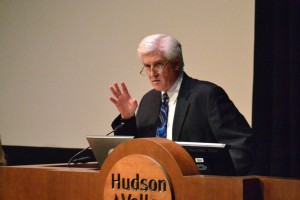Yay or Neigh: The hidden side of the horse racing industry unveiled

Nichole Danyla, Staff Writer
“[Horses] can’t speak for themselves, so we have to be their voice,” said Holly Cheever, the current vice president of the New York State Humane Society on Wednesday, Apr. 16 at the “After the Finish Line: Saving America’s Horses,” a seminar that was hosted by the Animal Outreach Club.
The seminar was meant to draw attention to how race horses are treated during their career and after they pass their prime.
Luis Belman, president of the Animal Outreach Club, said that this presentation was based on the recent documentary released by PETA about the treatment of horses at the famous Saratoga racetrack.
According to Belman, the PETA documentary got a lot of attention nationally, but there was no real local coverage.
Several people, including Steve Caporizzo, WTEN meteorologist and animal lover, alluded to the fact that The New York Racing Association (NYRA) plays a large part in the local economy, thus enabling them to see to it that stories reflecting the true nature of the industry are buried.
Caporizzo has been pushing for News Channel 10 to do a story about what really goes on behind the scenes at NYRA every year and it has always been denied.
“I can have all of the footage in the world [of what goes on], but if they say no it will never make it to air. It is one of the subjects that have been hidden in the back [of the] closet,” said Caporizzo.
The Animal Outreach Club also contacted a slaughterhouse in New Mexico to comment on allegations of how horses were treated and even offered to pay for their trip.
However, the slaughterhouse declined the offer to attend, as did much of the media.
The discussion focused on two main aspects of horse racing: doping in the sport to enhance and prolong the career of the horse, and the way horses are sold off, trafficked and slaughtered for human consumption in other countries.
“Racehorses are restrained and forced to be drugged,” said Sharon Boeckle, filmmaker of Kill Pen.
Friedlander, a former New York State Horse Racing and Wagering Board veterinarian and USDA Veterinary Trainer of the year, said he found racehorses with 119 different drugs in their system.
The Equine racing judges are former trainers that know what goes on but because they were in the business themselves they turn a blind eye when others do it.
Susan Kayne, a lifelong thoroughbred industry participant, said, “Behind NYRA’s gates it is business as usual, in the real world this is a crime.”
J.R Anderson said, “The whole industry is under a coven of silence.” Anderson is the author of the book The Fancy Hat Veneer about horse racing, breeding and slaughter.
Caporizzo said, “There is something terribly wrong here on so many levels.”
The second issue the panel wanted to address was the trafficking and slaughter of horses, especially thoroughbreds. Sick and dying horses aren’t the only ones sent to slaughter.
In fact, “92 percent of horses going to slaughter are completely healthy,” said Boeckle.
Kayne said, “2000 thoroughbred horses are slaughtered every year for human consumption.”
Once horses are auctioned off they are often shipped to Canada or Mexico to be slaughtered. Two of the major crossing points for meat hunters heading back to Canada are through New York, even though the trafficking and slaughter of horses is illegal in New York State.
Valerie Lang Waldin, assistant professor and librarian, and Anderson showed a presentation about slaughterhouses.
The presentation included two clips of horses being shot repeatedly. In one video a horse was shot several times before dying.
Some people had to get up and leave the room at this point.
The women also told the story of a Kentucky Derby winner called “Major Baby” who was sold to a slaughterhouse and shot 12 times before she died.
Holly Cheever said, despite the gruesome footage, “what was seen tonight was mild.”
Current laws on the books are not being enforced, so the panel asked those in attendance to write to senators about two new laws being to close down the horse trafficking border crossings in New York.
A billboard with a beaten and bloody horse will be put up on the highway near Saratoga to draw attention to this issue.
